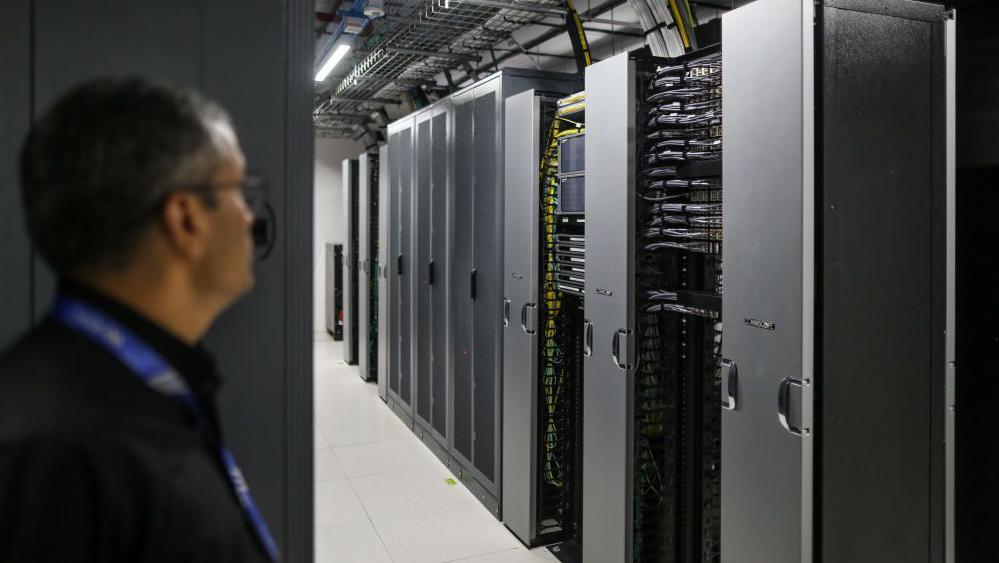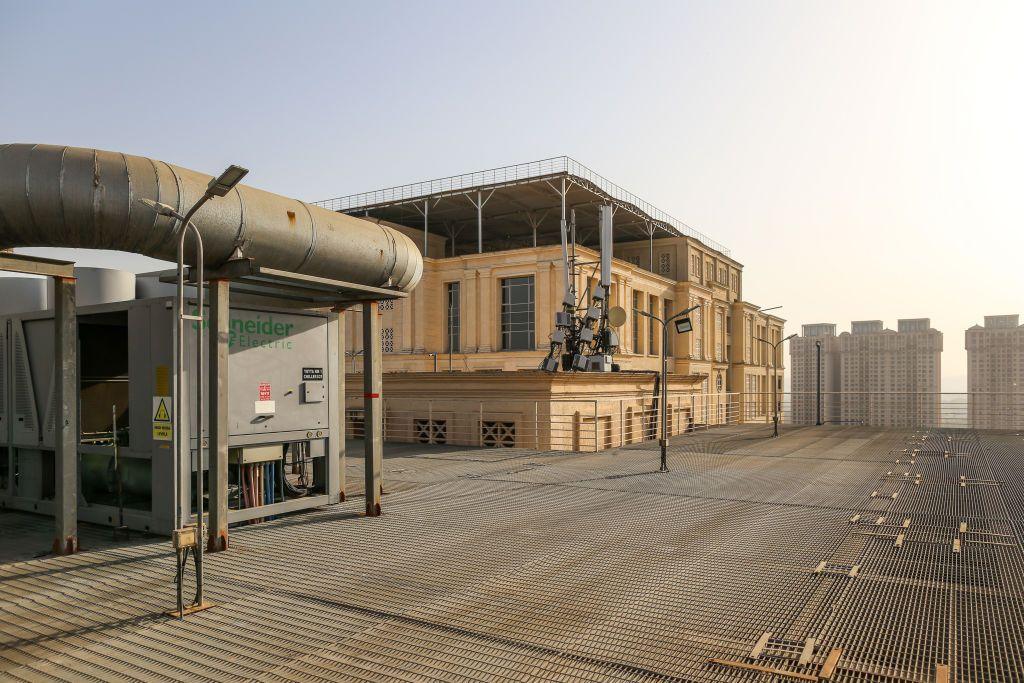India's data centre boom confronts a looming water challenge

India's data centre capacity is projected to surge 77% by 2027
- Published
The extraordinary rise of artificial intelligence has turbocharged data centre growth in India, Asia's third largest economy.
Data centres - the centralised physical facilities that enable our growing digital existence by hosting computer servers, IT infrastructure and network equipment - power everything from ChatGPT queries to electric vehicles and streaming services.
Last month, Google made an eye-popping $15bn (£11.49bn) investment in an AI data centre in the southern state of Andhra Pradesh - its biggest in India.
It was the latest among a string of investments from companies - including global giants like Amazon Web Services and Meta and local players such as Reliance Industries - that are pumping billions of dollars into India's data centre market. Even luxury real-estate developers have joined the bandwagon to build these computing facilities.
The sector is poised for "explosive growth", according to global real estate advisory JLL, with India's data centre capacity projected to surge 77% by 2027 to reach 1.8GW. Some $25-30bn is expected to be spent in capacity expansion by 2030, according to various estimates.
While vital for India's developmental needs, the growth of such energy hungry, water-guzzling infrastructure has profound implications for the country's decarbonisation plans.

India has 18% of the world's population, but only 4% of its water resources
India has no option but to attract big data centre investments, some experts say.
While the country is said to account for 20% of global data generation, it has only 3% of global data centre capacity. And demand for such infrastructure is soaring, with India expected to consume the most data in the world by 2028 - higher than developed markets like the US, Europe and even China.
This consumption is being driven by massive growth in internet and mobile use, the government's regulatory thrust on hosting user data locally and rapid adoption of AI, which has greater computing needs. AI chatbots like ChatGPT have their second largest user base in India.
There's also a strong business case for Indian policymakers to push for such investments and for global firms to commit the money.
According to Kotak Research, "data centre development cost is one of the lowest in India with only China's cost being lower", and India's electricity cost is a fraction of the US, UK and Japan.
The country also has world-class tech talent suited for the industry's growth.
"Just like we exploited the IT services boom through the 90s and 2000s, this is another opportunity that we can use to our advantage," Vibhuti Garg, director for South Asia at the Institute for Energy Economics and Financial Analysis, told the BBC.

India's data consumption is being driven by massive growth in internet and mobile use
This boom has, however, presented policymakers with difficult trade-offs.
From Chile and Mexico to Georgia in the US and Scotland, serious concerns have been raised around data centres guzzling excess water for their cooling systems and consuming vast amounts of energy at the cost of local communities.
In an energy starved, water-scarce India, these challenges are even more accentuated.
According to the World Bank, India has 18% of the world's population, but only 4% of its water resources, making it among the most water-stressed countries in the world.
India's data centre water consumption, meanwhile, is expected to more than double from 150 billion litres in 2025 to 358 billion litres by 2030, putting further pressure on its water table.
Moreover, most of India's data centres are concentrated in urban clusters like Mumbai, Hyderabad, Chennai and Bengaluru which have strong competing water needs.
A potential pushback from locals or a loss of licences to build and operate such centres as a result of growing water stress could hit the industry hard over the long term, experts say.
There are already some murmurs of discontent.
Advocacy groups like the Human Rights Forum, external have raised "alarm" over the Andhra Pradesh state government's "public resource diversion" for Google's proposed data centre, saying that Visakhapatnam city where it is slated to come up is already facing acute water stress which could intensify as a result of this investment.
Google directed the BBC to a document which says that the company uses a "peer-reviewed context-based water-risk framework" to evaluate local watershed risk at new sites to guide decision-making on whether to use a freshwater source.
While India has explicit policies and regulations that govern data protection and data centre development, zoning, energy use etc, "water use does not figure prominently in any of these policy groups, and is a significant blind spot that places high risk on the long-term functioning of these centres", Sahana Goswami of WRI India, a water research organisation, told the BBC.
An S&P Global study predicts that 60-80% of India's data centres will face high water stress in this decade itself as a result of limited resource availability.
This, in turn, could have a cascading impact on other industries.
"Imagine shutdowns of data centres in peak summer due to lack of water for cooling - how might this impact banking services, medical systems in hospitals using cloud services, transit system operations and more," says Ms Goswami.
Companies need to bring greater innovation and explore mechanisms to use treated domestic and industrial waste water instead of fighting for this limited resource, experts say.
"India itself has examples of such innovation in the data centre space in Navi Mumbai. Further, various power and textile industries are much ahead in partnering with municipal authorities and water utilities," says Ms Goswami.
Praveen Ramamurthy, a water recycling expert from the Indian Institute of Science in Bengaluru city, agrees.
"Non-potable or treated water must be made mandatory for cooling needs," he told the BBC, adding that India must also select "low-stress water basins for new projects".
He also advocates for the use of zero-water cooling technologies that are advancing globally, but "inconsistently deployed across Indian and legacy facilities".

Most of India's data centres are concentrated in urban clusters like Mumbai, Hyderabad, Chennai and Bengaluru
A lesser, but significant concern apart from water, is energy use.
According to the International Energy Agency (IEA), India's electricity consumption for data centres is expected to double from 0.5-1% of the country's total power demand to around 1-2%.
"This could mean increased use of fossil fuel-based energy, because right now there is no regulation that forces data centres to use renewable energy," says Ms Garg.
While many data centres in India have signed contracts with renewable energy companies to mitigate their carbon footprint, formally "mandating the use of clean energy" will make this growth more sustainable, she adds.
Delhi will clearly have to strike a delicate policy balance as it supercharges its futuristic digital aspirations while also ensuring there's least damage to the environment.
"In the end, we need to ensure that one good is not sacrificed for another," says Ms Garg.
Follow BBC News India on Instagram, external, YouTube,, external X, external and Facebook, external.